
The World Health Organization says air pollution is one of the world’s most serious environmental health risks. Pollutants include particulate matter, carbon monoxide, ozone, nitrogen dioxide and sulfur dioxide. Breathing in this pollution increases the risk of stroke, heart disease, lung cancer, and exacerbates both chronic and respiratory diseases, including asthma. (World Health Organization, 2022).
Given what we've been breathing in from the Canadian forest fires lately, on top of the usual amount of pollution we're regularly exposed to here in New York City, I did a search to see if there are natural ways to protect ourselves from air pollutants in general and found these suggestions.
Maybe some of them will be helpful to you.
NATURAL REMEDIES TO MINIMIZE THE EFFECTS OF AIR POLLUTION
TURMERIC:

Turmeric, a mainstay of Ayurvedic medicine, has antibacterial and antioxidant properties that help treat and manage lung conditions. Oxidative damage is one of the mechanisms responsible for many diseases. Free radicals react with organic substances in the body, creating chronic low-level inflammation, which can cause autoimmune diseases. The curcumin in turmeric is a powerful antioxidant and anti-inflammatory that neutralizes free radicals. (Airly, 2023), (Kunik, 2022), (Tega Organic Tea, 2020) & (Whyand, 2018).
BEETROOT TEA:

Beets, along with beet greens, are rich in nitrates proven to improve lung function. Nitrates relax blood vessels, reduce blood pressure and optimize oxygen. They have also been shown to improve physical performance and lung function in people with chronic lung conditions. Beet greens are rich in magnesium, potassium, vitamin C and carotenoid antioxidants, all of which aid good lung health. (Basu, 2022).
Notes: The nitrates in beetroot make it a natural blood thinner so might negatively interact with certain blood pressure medications, leading to a severe drop in blood pressure. (Singh, 2023).
If you're on a blood thinner (anti-coagulant) medicine such as Warfarin, see Eating Beets When Taking Blood Thinning Medicine. (Greenwood, 2023).
I take Eliquis. This was my cardiologist's response when I asked him about beetroot tea:
"I find nothing in the literature about interactions with oral anticoagulants. However, given its potential blood thinning effects, I recommend taking limited amounts." (Morlote, 2023)
TURMERIC TEA AND GOLDEN MILK:

The anti-inflammatory and antioxidant properties of curcumin can alleviate the symptoms of chronic or long-lasting lung conditions. A 2017 medical review concluded that curcumin could help treat asthma, pulmonary and cystic fibrosis, lung cancer, lung injury and chronic obstructive pulmonary disease. (Medical News Today, 2022)

Turmeric is the ingredient that gives the tasty, hot, Ayurvedic drink, Golden Milk, its beautiful golden color.
The basic ingredients in Golden Milk are an animal or plant milk of your choice, turmeric, cinnamon, ginger and a sweetener like honey. Recipes may also include black pepper, nutmeg or other spices.
GREEN TEA:

A 2022 study found clinical evidence of green tea’s protection against respiratory tract infections. The catechins in green tea provide anti-bacterial, anti-oxidative, anti-viral and anti-inflammatory effects that inhibit the adsorption and replication of the influenza virus. Theanine and vitamin C in green tea also enhance immunity against viral and bacterial infections. (Zasshi, 2022).
TULSI TEA:
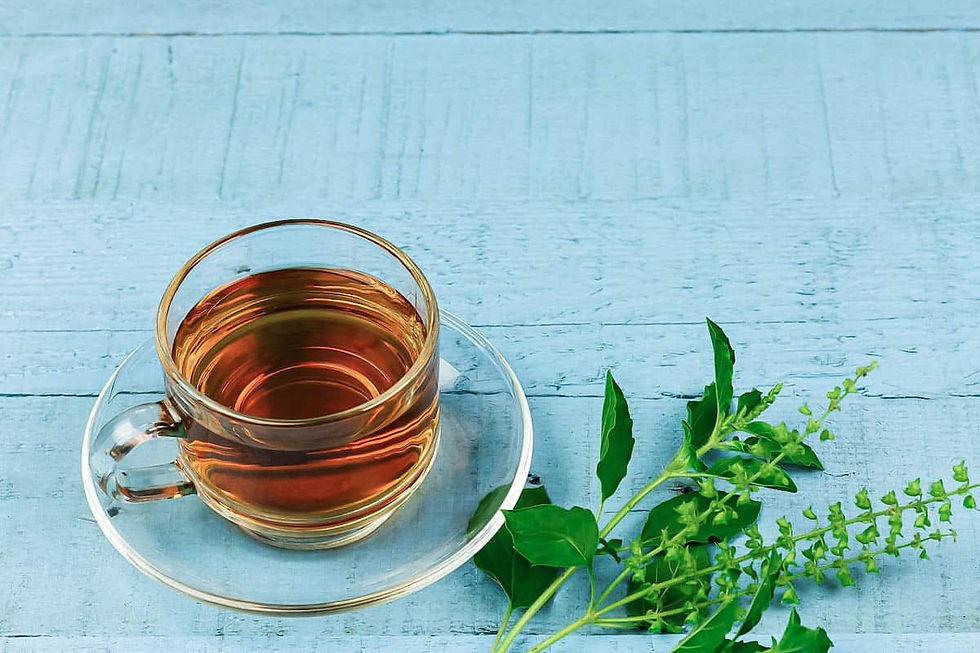
Another Ayurvedic herb, tulsi (AKA Holy Basil) has long been known to improve lung and respiratory health. It has potent anti-inflammatory, antibacterial and anti-viral properties.Tulsi helps clear gunk out of the lungs and promotes healing from inflammation in the airways. (Roy, 2021).
A small pot of this herb is easy to grow at home so you could brew up a cup of fresh tulsi tea whenever you like.
GINGER LEMON TEA:

Ginger lemon tea, made by boiling ginger root with lemon in water, straining the tea and adding honey, is an age old remedy for colds, cough and congestion.
The anti-inflammatory properties of ginger combine with the vitamin C in lemon to heal sore throat and improve overall lung function. (Roy, 2021)
PEPPERMINT TEA:

Drinking a refreshing tea made from fresh peppermint helps fight the negative effects of the irritants and toxins in air pollution.
Peppermint is rich in both anti-oxidant and anti-histamine properties that ease congestion in the respiratory tract. (Phelamei, 2019).
Make your tea even healthier by using organic peppermint.
For all these therapeutic teas, you'll get considerably greater benefit making them with fresh herbs rather than giving in to the convenience of dried herbs in teabags.
GHEE:
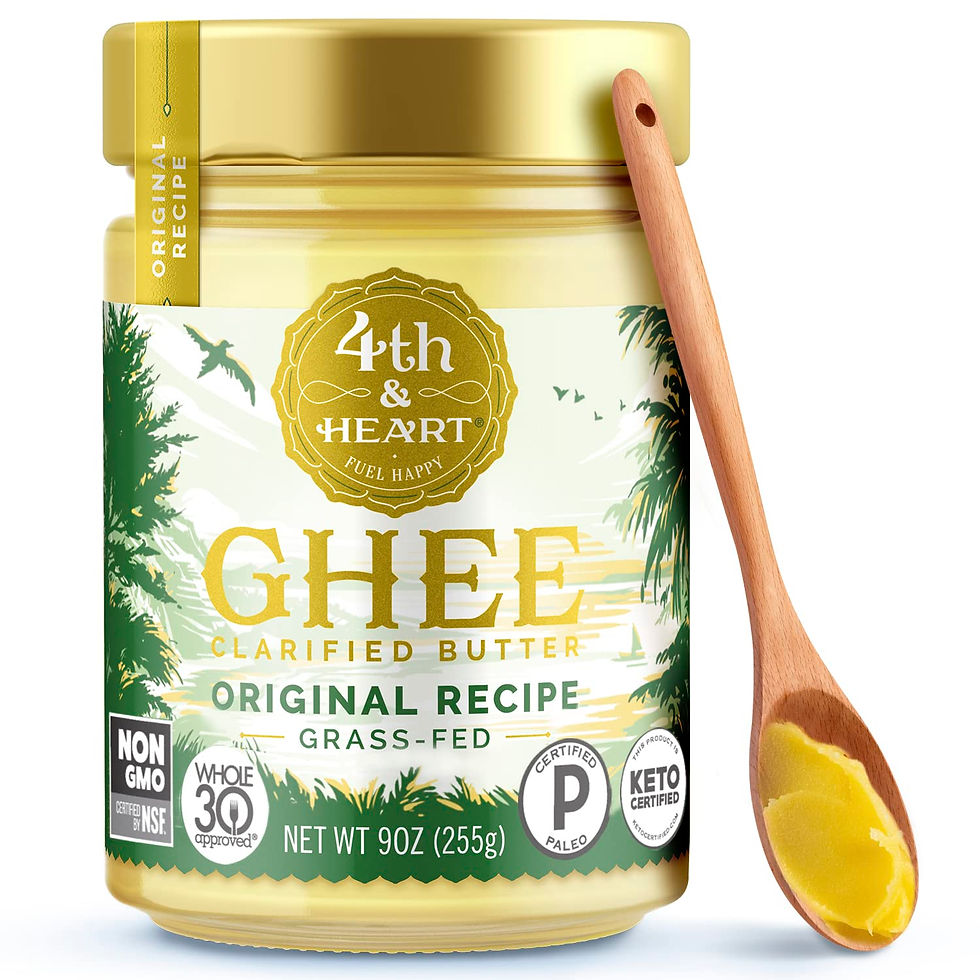
Do as they do in India to reduce the negative effects of air pollutants. Apply a thin layer of ghee (clarified butter) to the inner walls of your nostrils to prevent the entrance of air pollutants into your lungs. This Ayurvedic practice, called Nasya Karma, clears the nasal passages, preventing sinus congestion, asthma and other respiratory disorders. The practice also clears the whole respiratory tract and relaxes muscles.
Eat some organic ghee too. It’s got anti-inflammatory, antioxidant and anti-allergic properties. It also tastes delicious and doesn’t need to be refrigerated. (Airly, 2023) & (Suresh Foods, 2016).

Since learning about this, I’ve been putting a thin layer of organic ghee inside my nostrils before I go outside and am finding it both helpful and soothing.
Ghee made from cow's milk is fairly easy to find. If you prefer ghee made from goat's milk, I highly recommend this one from Mt. Capra Goat Farm in Washington State. All their grass-fed goat's milk products are top quality and the company has excellent customer service.
JAGGERY SUGAR (AKA GUR):
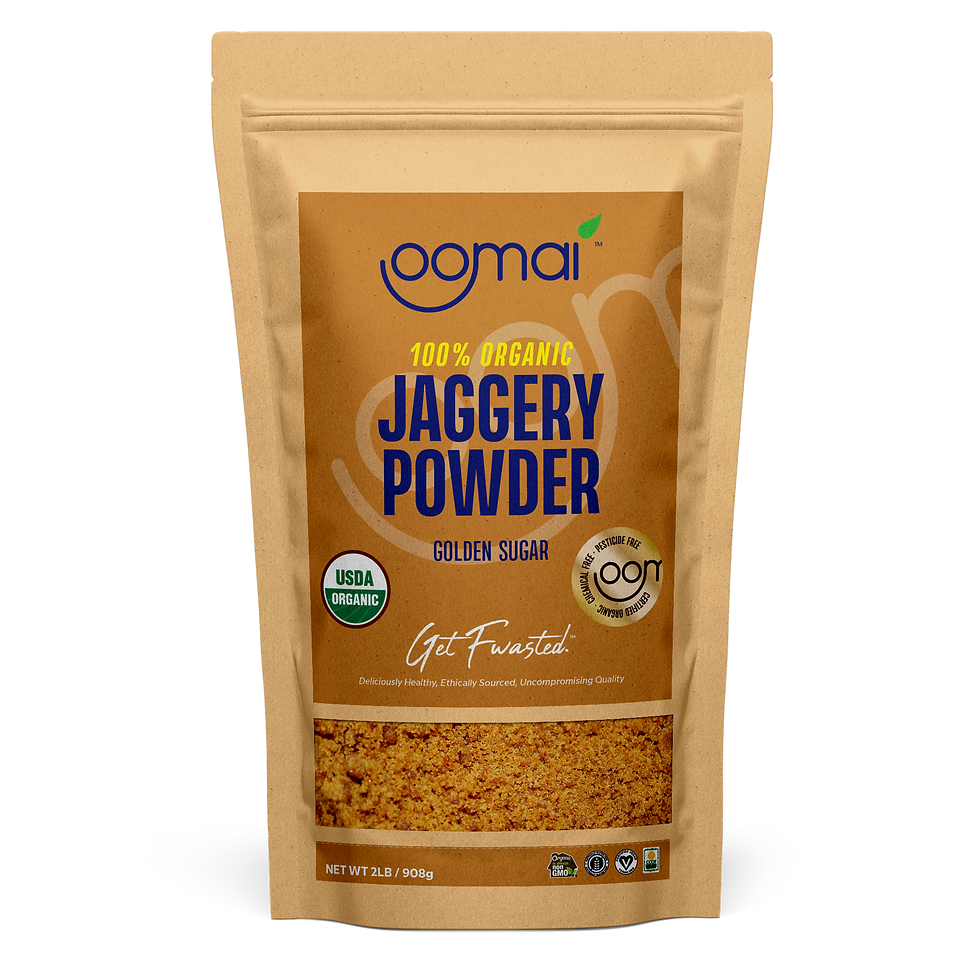
Jaggery sugar (AKA Gur) is made from unrefined cane sugar and is a rich source of iron, which boosts hemoglobin levels in the blood, increasing the oxygen-carrying capacity of the blood. This helps fight the negative effects of breathing-related issues caused by air pollutants. (Airly, 2023) & (Sahu & Saxena, 1994).
The health benefits of jaggery make it considerably healthier than white refined sugar, which is pure sucrose so basically provides empty calories and no health benefits. Jaggery has long been used in Ayurvedic medicine to ease respiratory conditions like bronchitis and asthma. The vitamin C content in jaggery helps reduce inflammation throughout the body. (Max Lab, 2023).
Jaggery also contains proteins; vitamins E, A, B5, B6, B2 and B1; potassium; phosphorous; calcium; magnesium; sodium; copper; iron and zinc. (Barode, 2022).
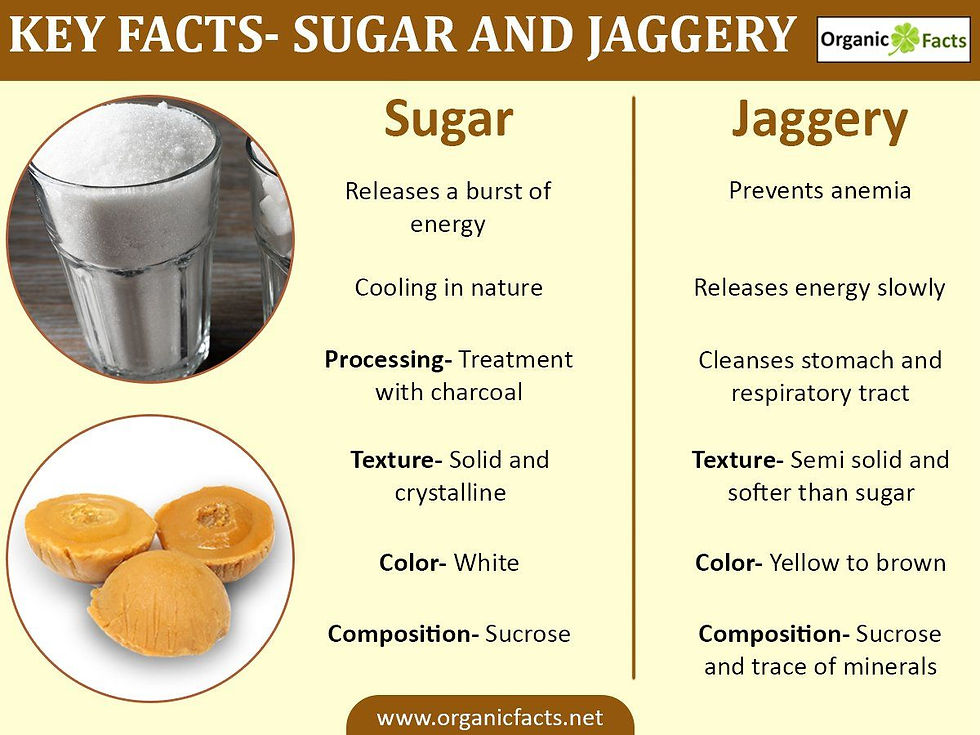
BETA-CAROTENE:

Beta-carotene is useful for controlling inflammation levels in the body. It stimulates antioxidant activity. Boosts eye, respiratory, heart and skin health. It also elps prevent macular degeneration, cancer and dandruff. Hows that for a wide range of benefits?!
The richest sources of beta-carotene are brightly colored yellow, orange and green leafy vegetables and fruits - including sweet potatoes, pumpkins, acai berries, carrots, Swiss chard, kale, spinach, lettuces, tomatoes, broccoli, cantaloupe, lettuce, coriander leaves, peaches, apricots, papayas, mangoes, winter squash, and fenugreek.
The more intense the color, the more beta-carotene the fruit or vegetable contains. (Airly, 2023) & (Emily, 2019)
Notes: See Beta Carotene Benefits, Signs of Deficiency and Food Sources for information on:
* What happens if we consume too much Beta-Carotene?
* What happens if we don’t consume enough Beta-Carotene?
* Special precautions & warnings
- Emily, 2019
CYPRESS OIL:
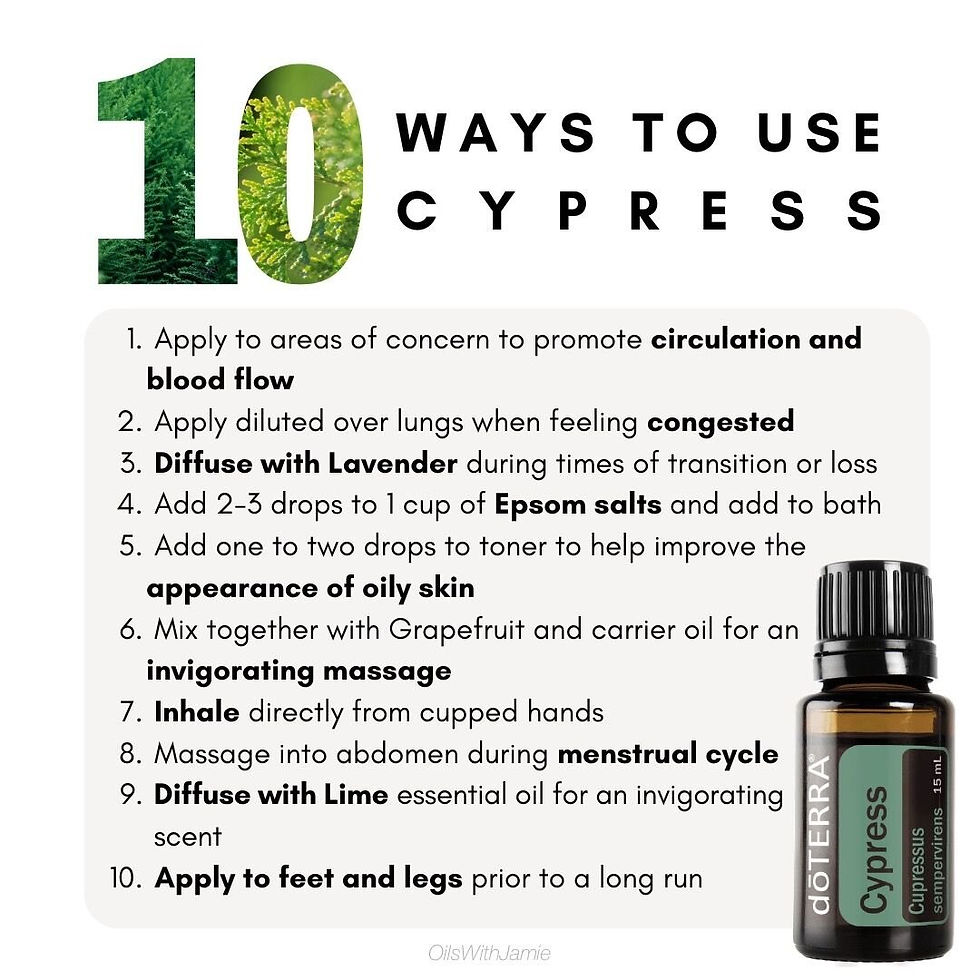
Cypress oil has traditionally been used as a remedy to treat pain and inflammation, skin conditions, headaches, colds and coughs.
It's also used to clear up respiratory congestion and eliminate phlegm in the respiratory tract and lungs.
Cypress oil works as an antispasmodic in the respiratory system so also is good for treating more severe respiratory conditions. like asthma and bronchitis.
It’s also an antibacterial agent that’s useful for treating respiratory infections caused by bacterial overgrowth.
“A 2004 study published in the Journal of Agricultural and Food Chemistry found that a component present in cypress oil, called camphene, inhibited the growth of nine bacteria and all yeasts studied. This is a safer alternative than antibiotics that can lead to damaging side effects like leaky gut syndrome and loss of probiotics.”
“You can also dilute cypress with a carrier oil and apply the mixture to the chest to work as a vapor rub. To reduce phlegm, add 3–5 drops of cypress oil to boiling water, place a towel over your head and breathe in the steam for 5-10 minutes.” (Axe, 2017)
"Research has found that when the aroma from essential oil is inhaled, it activates a part of your limbic system - a section of your brain responsible for behaviors, emotions, long-term memory, and sense of smell. The limbic system plays a role in creating memories and modulating certain physiological functions, like heart rate, breathing, and blood pressure."
Inhaling cypress oil "gives energy to improve circulation and bring energy to the diaphragm to support the release of constriction and tension."
".... On the physical level, Cypress oil is known to clear up congestion and eliminates phlegm that builds up in the respiratory tract and lungs. The oil calms the respiratory system and works as an antispasmodic agent. Essential oils, like Cypress, can be warming in nature which helps them enhance blood flow and improve circulation by relaxing the blood vessels and supporting the health of the blood vessels."
"Just smelling Cypress can help create a feeling of security and grounding to help enhance emotional flexibility." (Cohen, 2023)
Safety Concerns for Cypress Essential Oil
“It is not safe to use cypress essential oil internally. When used aromatically or topically, cypress oil is generally safe and non-toxic. It should also be avoided during pregnancy, and there is not enough research to support its safety for children. Make sure to perform a patch test before using cypress oil directly on the skin. It is safest to dilute cypress with a carrier oil before topical use.” (Axe, 2017)
Health and Clinical Impacts of Air Pollution and
Linkages with Climate Change
(Keswani et al, 2022)
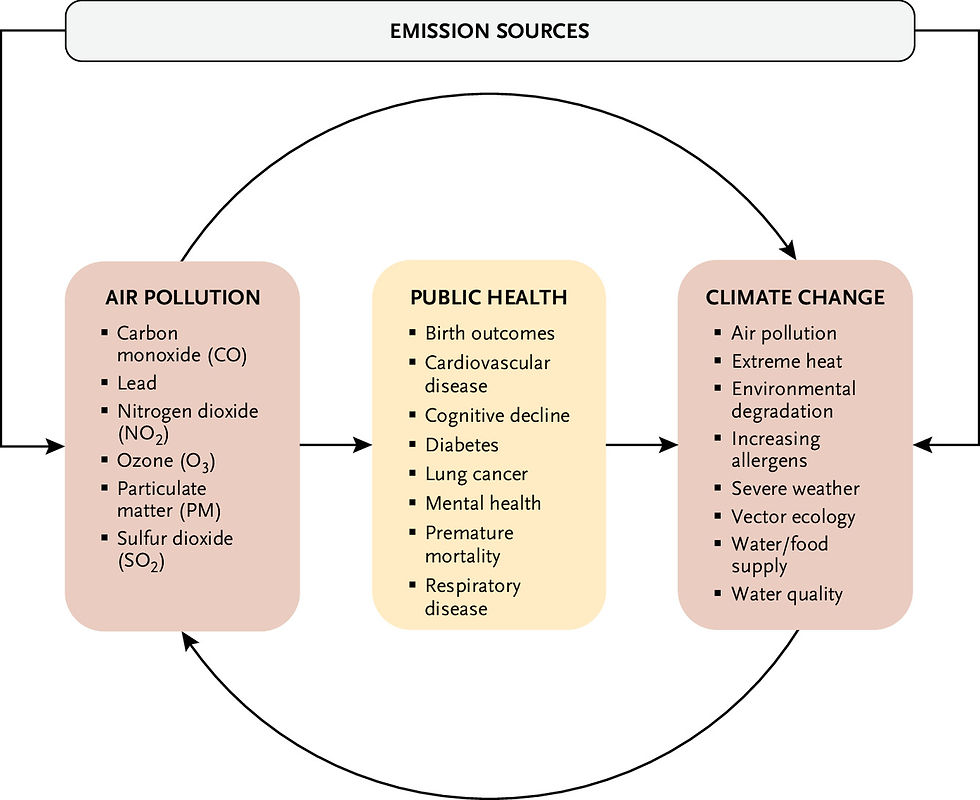
OTHER NUTRIENTS THAT ARE PROTECTIVE AGAINST POLLUTION
A 2018 literature review looked into which foods and nutritional supplements help respiratory diseases caused by pollution. The researches found evidence suggesting that carotenoids, vitamin D and vitamin E provide protection against pollution’s respiratory damages, like COPD, asthma and lung cancer. The review suggested that vitamin C, choline and omega-3 fatty acids may also be protective. (Whyand, 2018).
Here are some dietary sources of these nutrients:
CAROTENOIDS:

These brightly colored fruits and vegetables. are food sources rich in carotenoids. (WebMD, 2021).
VITAMIN D:

Salmon, swordfish, tuna, sardines, beef liver, egg yolks and mushrooms are rich food sources of vitamin D. (Harvard T.H. Chan School of Public Health, 2023).

This graphic shows how vegans can get vitamin D in their diets. Since these foods are poorer sources of D, supplementing with vitamin D3 is a good idea for vegans.
In my opinion, based on reading and personal experience, we all should be supplementing with Vitamin D3 to get our 25-Hydroxy blood serum level to somewhere between 60-90 ng/mL.
This is one of several articles about the importance of Vitamin D I've written for this site: Vitamin D for Coronavirus … and Much More.
VITAMIN E:

Almond, hazelnut and peanut nuts and nut butters, sunflower seeds and sunflower oil, leafy greens, butternut squash, green peppers, asparagus, kiwis, mangoes and avocados are good sources of vitamin E. (Harvard T.H. Chan School of Public Health, 2023).
VITAMIN C:
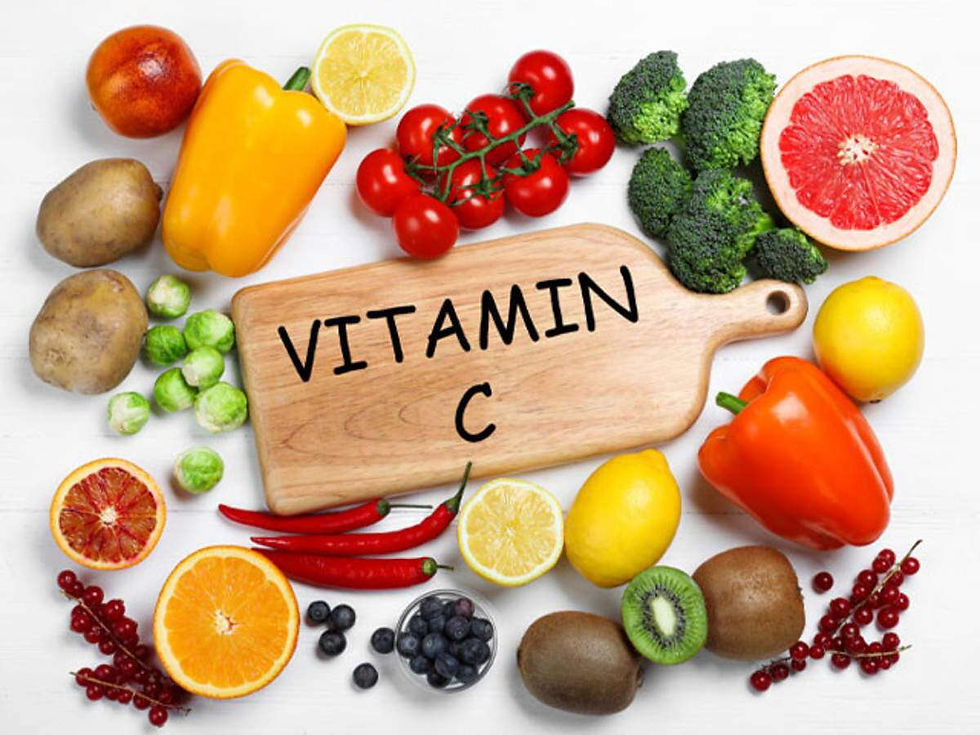
Exposure to air pollution increases oxidative damage in our bodies so it's important to give our bodies enough anti-oxidant nutrients to counteract the damage.
"Vitamins C and E are two of the best, and are especially important when it comes to protecting the lungs. Both of these antioxidants are found in the lungs and have long been studied for their protective effects against air pollution. When exposed to different types of air pollution including ozone, fine particulate matter, and nitrogen dioxide, the lung’s natural antioxidant defenses are depleted, making it critical to replenish them. Vitamins C and E enhance the activity of the lungs’ internal antioxidant defenses, restoring antioxidant levels back to normal and effectively decreasing oxidative damage. Further, a number of studies show that supplementation with C and E protects normal lung function in children and adults, with and without asthma, when exposed to both acute and long-term air pollution. Aim for at least 500 mg of vitamin C and 400 mg of vitamin E daily." (Wilson, 2023) & (Nye, 2022)
CHOLINE:

Eating whole eggs, organ meats, fish, shiitake mushrooms, soybeans, beef, chicken, turkey, cruciferous vegetables, almonds, lima beans, red potatoes, kidney beans, quinoa, cottage cheese provides choline in your diet. (Kubala, 2023).
OMEGA-3 FATTY ACIDS:

Omega-3 fatty acids are important for staying healthy because they are anti-inflammatory in the body. In contrast, a diet heavy in processed foods is heavy in inflammatory omega-6 fatty acid. While the body requires some amount of omega-6 fatty acids to function, people who live mostly on fast food and other heavily processed foods are consuming way too much omega-6 and way too little omega-3, creating a state of chronic, low-level inflammation which can eventually lead to various auto-immune diseases.
Mackerel, salmon, cod liver oil, herring, oysters, sardines, anchovies, caviar, flax seeds, chia seeds, walnuts, omega-3-enriched eggs, meats and dairy products from grass-fed animals are good sources of healthy omega-3 fatty acids. (Hjalmarsdottir, 2023).
W.H.O.’S LIST OF OUTDOOR AIR POLLUTANTS

In case you're interested in knowing what’s in the polluted air you’re breathing in, this is the list the World Health Organization published in December 2022. Reading it isn’t for the faint of heart:
Particulate matter (PM) PM is a common proxy indicator for air pollution. There is strong evidence for the negative health impacts associated with exposure to this pollutant. The major components of PM are sulfates, nitrates, ammonia, sodium chloride, black carbon, mineral dust and water.
Carbon monoxide (CO) Carbon monoxide is a colourless, odourless and tasteless toxic gas produced by the incomplete combustion of carbonaceous fuels such as wood, petrol, charcoal, natural gas and kerosene.
Ozone (O3) Ozone at ground level – not to be confused with the ozone layer in the upper atmosphere – is one of the major constituents of photochemical smog and it is formed through the reaction with gases in the presence of sunlight.
Nitrogen dioxide (NO2) NO2 is a gas that is commonly released from the combustion of fuels in the transportation and industrial sectors.
Sulfur dioxide (SO2) SO2 is a colourless gas with a sharp odour. It is produced from the burning of fossil fuels (coal and oil) and the smelting of mineral ores that contain sulfur.
- (World Health Organization, 2022).
And this is what the Canadian Government said at the end of June 2023 about the wild fires burning out of control there:
About wildfire smoke events
"Communities across Canada regularly experience wildfire smoke events. This is expected to continue as Canada is warming much faster than the rest of the world, providing ideal conditions for more frequent and longer wildfires. Wildfire season typically runs from early April to late October. As wildfires burn through forests and grasslands, they produce dense smoke.
"It is difficult to predict:
when fires will occur
how big they will be
how much smoke they will generate
what direction the smoke will travel
"Wildfire smoke may be carried hundreds or thousands of kilometres from the fire zone. This means smoke from other parts of the world can impact communities in Canada."
Wildfire smoke and pollution levels
"Smoke from wildfires can be a major source of air pollution for people in Canada.
"Wildfire smoke is a complex mixture of gases, particles and water vapour that contains pollutants such as:
sulphur dioxide
nitrogen dioxide
carbon monoxide
volatile organic compounds
fine particulate matter (PM2.5)
ozone
"It is the fine particles (PM2.5), not visible to the human eye, that get deep into our lungs and bloodstream. These fine particles pose the main health risk from wildfire smoke.
"There’s no evidence of a safe level of exposure for some of these pollutants. This means that smoke can impact your health even at very low levels. As smoke levels increase, your health risks increase. Air pollution may be present even when you can’t see or smell smoke. (emphasis added)" - Government of Canada, 6/30/2023
See Wildfire smoke, air quality and your health to watch the government issued video and read the whole article.

Given that dangerous air pollution is likely to be with us from here on, it would be wise to do what we can to protect ourselves from its toxic effects as much as possible.
My plan - at least for now - is to stock up on organic ghee (for inside my nostrils), eat a lot of brightly colored fruits and veggies (for their beta-carotene and carotenoids), cook more curries (for the curcumin), and use fresh herbs to make myself some of the recommended teas.
I’ll also continue supplementing daily with vitamin D3 and Omega-3 fatty acids (plus eating foods rich in these nutrients); eating choline and vitamin E-rich foods; inhaling cypress oil several times a day; using jaggery in lieu of processed white sugar; and eating organic, non-GMO and pasture-raised produce, meats, fish, eggs and dairy products whenever possible (to avoid consuming other toxins and unnecessary antibiotics).
This is what we and all living things want to do:

Could you please leave a comment if you found this post interesting? It would be much appreciated & would help spread the word.
The COMMENT box is at the bottom of the page, below the REFERENCES.
REFERENCES
Airly. (2023). 6 Natural Remedies for Air Pollution - And What Can You Do to Improve Air Quality Around You? See: https://airly.org/en/6-natural-remedies-for-air-pollution-what-can-you-do-to-improve-air-quality-around-you/
Axe, J. (2017). 8 Surprising Benefits of Cypress Essential Oil. See: https://draxe.com/essential-oils/cypress-essential-oil/
Barode, S. (2022). Jaggery: Uses, Benefits, Side Effects By Dr. Smita Barode. PharmEasy. See:
Basu. S. (2022). 10 foods to help you breathe better and promote your lung health. See: https://www.lifestyleasia.com/ind/dining/food/foods-to-breathe-better-and-promote-your-lung-health/
Cohen, J.S. (2023). Release Your Diaphragm with Essential Oils. Vibrant Blue Oils. See: https://vibrantblueoils.com/release-your-diaphragm-with-essential-oils/
Emily. (2019). Beta Carotene Benefits, Signs of Deficiency and Food Sources. Health Benefits Times. See: https://www.healthbenefitstimes.com/nutrition/beta-carotene/
Government of Canada. (6/30/2021). Wildfire smoke, air quality and your health. See: https://www.canada.ca/en/environment-climate-change/services/air-quality-health-index/wildfire-smoke.html#
Greenwood, B. (2023). Eating Beets When Taking Blood Thinning Medicine. LiveStrong. See: https://www.livestrong.com/article/499288-eating-beets-when-taking-blood-thinning-medicine/https://www.livestrong.com/article/499288-eating-beets-when-taking-blood-thinning-medicine/
Hardin, J.R. (2020). Vitamin D for Coronavirus … and Much More. See: https://www.allergiesandyourgut.com/post/vitamin-d-for-coronavirus-and-much-more
Harvard T.H. Chan School of Public Health. (2023). Vitamin D. The Nutrition Source. See: https://www.hsph.harvard.edu/nutritionsource/vitamin-d/
Harvard T.H. Chan School of Public Health. (2023). Vitamin E. The Nutrition Source. See: https://www.hsph.harvard.edu/nutritionsource/vitamin-e/
Hjalmarsdottir, F. (2023). 12 Foods That Are Very High in Omega-3. Healthline. See: https://www.healthline.com/nutrition/12-omega-3-rich-foods#1.-Mackerel-(4,580-mg-per-serving)
Keswani, A. et al. (2022). Health and Clinical Impacts of Air Pollution and Linkages with Climate Change. New England Journal of Medicine Evidence, 1:7. See: https://evidence.nejm.org/doi/full/10.1056/EVIDra2200068https://evidence.nejm.org/doi/full/10.1056/EVIDra2200068
Kubala, J. (2023). 16 Foods That Are High in Choline. Healthline. See: https://www.healthline.com/nutrition/foods-with-choline
Kunik, K. (2022). 4 Foods High in Curcumin, and How to Use It to Quell Inflammation. LiveStrong. See: https://www.livestrong.com/article/142078-foods-with-curcumin/
Max Lab. (2023). Health Benefits of Jaggery and Its Side Effects. See: https://www.maxlab.co.in/blogs/health-benefits-of-jaggery-and-side-effects#:~:text=The%20vitamin%20C%20content%20in,conditions%20like%20bronchitis%20and%20asthma
Medical News Today. (2022). 10 health benefits of turmeric tea. See: https://www.medicalnewstoday.com/articles/306981#nutrition-of-turmeric
Morlote, M. (2023). Personal communication.
Nye, J. (2022). Vitamin C Supplementation and Protective Effects Against Exposure to Air Pollution. Cardiology Advisor. See: https://www.thecardiologyadvisor.com/home/topics/vascular-medicine/vitamin-c-supplementation-and-protective-effects-against-exposure-to-air-pollution/#:~:text=Vitamin%20C%20Supplementation%20and%20Protective%20Effects%20Against%20Exposure%20to%20Air%20Pollution,-Jessica%20Nye%2C%20PhD&text=Vitamin%20C%20supplementation%20may%20protect,in%20Ecotoxicology%20and%20Environmental%20Safety
Phelamei, S. (2019). Peppermint tea benefits: Drink this herbal tea to protect yourself from air pollution. Times Now News. See: https://www.timesnownews.com/health/article/peppermint-tea-benefits-drink-this-herbal-tea-to-protect-yourself-from-air-pollution/507051
Roy, N. (2021). Tea recipes that can help protect from the side-effects of pollution. Times of India. See: https://timesofindia.indiatimes.com/life-style/food-news/tea-recipes-that-can-help-protect-from-the-side-effects-of-pollution/photostory/87588857.cms
Sahu, A.P. & Saxena, A.K. (1994). Enhanced translocation of particles from lungs by jaggery. Environmental Health Perspectives, 5:211-214. See: https://www.ncbi.nlm.nih.gov/pmc/articles/PMC1567304/
Singh, R. (2023). Beetroot Juice: Uses, Benefits, Side Effects and More! See: https://pharmeasy.in/blog/ayurveda-uses-benefits-side-effects-of-beetroot-juice/#Precautions_To_Take_with_Beetroot_Juice
Suresh Foods. (2016). Ghee – Ayurvedic remedy to fight Pollution & Smog by Boosting Immunity. See: https://sureshfoods.com/ghee-ayurvedic-remedy-to-fight-pollution-smog-by-boosting-immunity/#:~:text=According to gomataseva.org, it,in the air you breathe
Tega Organic Tea. (2020).10 Benefits of Turmeric. See: https://tegaorganictea.com/blogs/news/10-benefits-of-turmeric
WebMD. (2021). What to Know About Dietary Carotenoids. See: https://www.webmd.com/diet/what-to-know-about-dietary-carotenoids
Whyand, T. et al. (2018). Pollution and respiratory disease: can diet or supplements help? A review. Respiratory Research, 19: 79. See: https://www.ncbi.nlm.nih.gov/pmc/articles/PMC5930792/
Wilson, L. (2023). Air Pollution Is a Killer. Here's How to Protect Yourself. See: https://www.naturalgrocers.com/health-hotline-article/air-pollution-killer-heres-how-protect-yourself#:~:text=Further%2C%20a%20number%20of%20studies,mg%20of%20vitamin%20E%20daily.
World Health Organization. (2022). Air pollution. See: https://www.who.int/health-topics/air-pollution#tab=tab_1
Zasshi, Y. (2022). Benefits of Green Tea: Clinical Evidence for Respiratory Tract Infections. Pub Med. See: https://pubmed.ncbi.nlm.nih.gov/?term=Yamada+H&cauthor_id=36450515
© Copyright 2021. Joan Rothchild Hardin. All Rights Reserved.
DISCLAIMER: Nothing on this site or blog is intended to provide medical advice, diagnosis or treatment.


Comments